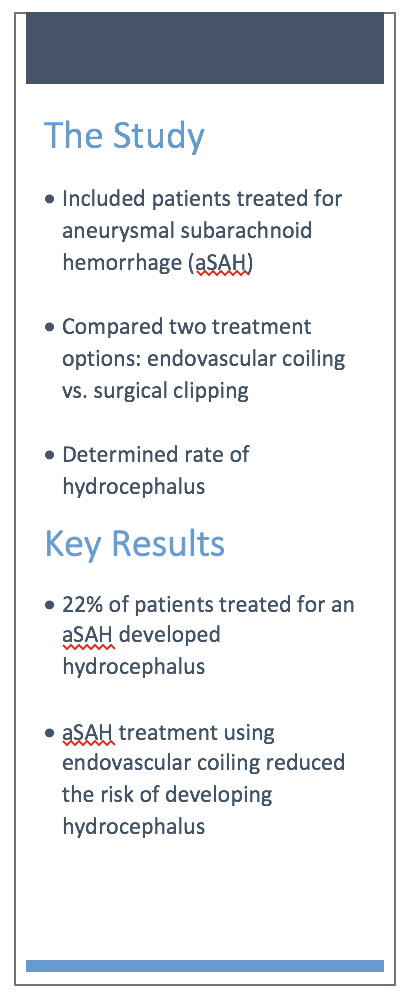Choice of Treatment could Alter Risk of Hydrocephalus After a Subarachnoid Hemorrhage
By: Dr. Jenna Koschnitzky, National Director of Research Programs | Hydrocephalus Association
Dr. Wendy Ziai, Medical Director, Neurovascular Laboratory | Associate Professor of Neurology, Johns Hopkins Hospital
Hydrocephalus research is conducted all over the world. A recent study published in the Journal of Neurosurgery sheds light on the risk of developing shunted hydrocephalus after a specific type of brain bleed. The study was authored by Dr. Masaomi Koyanagi and colleagues out of the National Hospital Organization Himeji Medical Center in Japan.

What was the study?
In the study, Dr. Koyangi compared two treatment options for people who suffer an aneurysmal subarachnoid hemorrhage (aSAH) and the risk of developing hydrocephalus.
What were the results?
The study found that 22% of all patients treated for aSAH developed hydrocephalus. The authors then matched patients on many factors including age, gender, and severity of the brain bleed. Using these matched groups, they found that 16% of people who were treated using endovascular coiling developed hydrocephalus compared to 30% of people who were treated using surgical clipping (1).
However, there are other advantages and disadvantages to the two treatment options (see: What are other studies saying?).
What is aSAH?
A subarachnoid hemorrhage (SAH) is a when a brain bleed occurs between specific tissue layers that cover the brain. A SAH can occur after a traumatic injury or when a brain aneurysm ruptures. When SAH is caused by an aneurysm, it is called an aneurysmal subarachnoid hemorrhage (aSAH).
What is a brain aneurysm?
A brain aneurysm is a blister on a blood vessel of the brain which can be detected either coincidentally when imaging of the brain occurs for a different reason, or when the aneurysm ruptures or causes symptoms. Not all aneurysms need to be treated, but those at risk for rupturing or which have ruptured (causing a subarachnoid hemorrhage) usually need to be treated.
What are the two treatment options?
There are two main treatment options which are opening surgical clipping and endovascular coiling. The choice of treatment is often made with both the neurosurgeon and a neurointerventional expert, who may be a neuroradiologist, neurosurgeon or neurologist. Choice of treatment depends on several factors including whether the aneurysm has ruptured, its size, shape and location.
Surgical clipping is performed by a neurosurgeon in the operating room under general anesthesia. The surgeon makes an incision in the scalp, opens the bone (called a craniotomy), and dissects through openings in the brain to find the aneurysm and place a clip around its neck so the aneurysm is no longer connected to the brain blood supply. The main advantage of clipping is that it usually requires only one procedure and is considered the definitive treatment to completely obliterate the aneurysm. It is also appropriate for certain aneurysm locations and shapes where coiling is not possible.
Endovascular coiling is increasingly preferred to surgical clipping in both ruptured and unruptured aneurysms. The coiling procedure is performed during the cerebral angiogram. The angiogram, which is a procedure used to diagnose an aneurysm involves inserting a catheter into the large artery at the top of the leg. The catheter is guided up through the aorta and up to the blood vessels of the brain and a contrast agent is injected to visualize the aneurysm. Detachable platinum coils are packed into the aneurysm where it originates from the blood vessel, which quickly form a clot and prevent blood from entering the aneurysm. The main advantage of endovascular coiling is a faster recovery (most patients with elective aneurysm coiling go home in 1-2 days, instead of 3-5 days after surgical clipping). The main disadvantage is that coiling has a slightly higher risk of rebleeding than clipping.
What are other studies saying?
In a multicenter randomized trial comparing microsurgical clipping and endovascular coiling of aneurysms, the intracranial subarachnoid aneurysm trial (ISAT), the outcome of survival free of disability at 1 year was significantly better with endovascular coiling compared to clipping (2). At 5 years, the risk of death was significantly less for patients treated with endovascular coiling vs. clipping (14% vs 11%), although the proportion of survivors who were independent was not different between the two groups (82% vs 83% respectively) (3). The rate of rebleeding from the treated aneurysm was higher for coiling than for clipping although the risk is small (10 cases vs. 3 cases, respectively in a population of 2004 patients).
There have been a number of advances in endovascular techniques in the last few years which allow previously untreatable aneurysms or high risk aneurysms to be repaired. These include: (i) placing a stent permanently into the blood vessel next to the aneurysm to keep the coils in place inside the aneurysm (stent-assisted coiling); and (ii) the use of flow diverting embolization devices which are placed similar to a stent, but act to divert flow away from the aneurysm and provide a scaffolding for the vessel wall to heal which results in eventual disappearance of the aneurysm.
For access to the full article by Koyanagi and colleagues, click here.
References:
- Koyanagi M, Fukuda H, Saiki M, Tsuji Y, Lo B, Kawasaki T, Ioroi Y, Fukumitsu R, Ishibashi R, Oda M, Narumi O, Chin M, Yamagata S, Miyamoto S MD. Effect of choice of treatment modality on the incidence of shunt-dependent hydrocephalus after aneurysmal subarachnoid hemorrhage. JNS. 2018: Published online March 9, 2018; DOI: 10.3171/2017.9.JNS171806.
- Molyneux A, Kerr R, Stratton I, Sandercock P, Clarke M, Shrimpton J, Holman R. International Subarachnoid Aneurysm Trial (ISAT) of neurosurgical clipping versus endovascular coiling in 2143 patients with ruptured intracranial aneurysms: a randomised trial. Lancet. 2002: 360: 1267-74.
- Molyneux AJ, Kerr RS, Birks J, Ramzi N, Yarnold J, Sneade M, Rischmiller J; ISAT Collaborators.
Risk of recurrent subarachnoid haemorrhage, death, or dependence and standardised mortality ratios after clipping or coiling of an intracranial aneurysm in the International Subarachnoid Aneurysm Trial (ISAT): long-term follow-up. Lancet Neurol. 2009;8(5):427-33.
